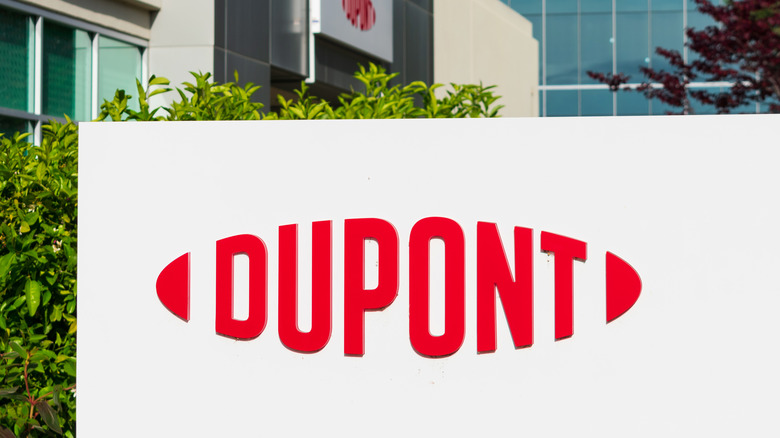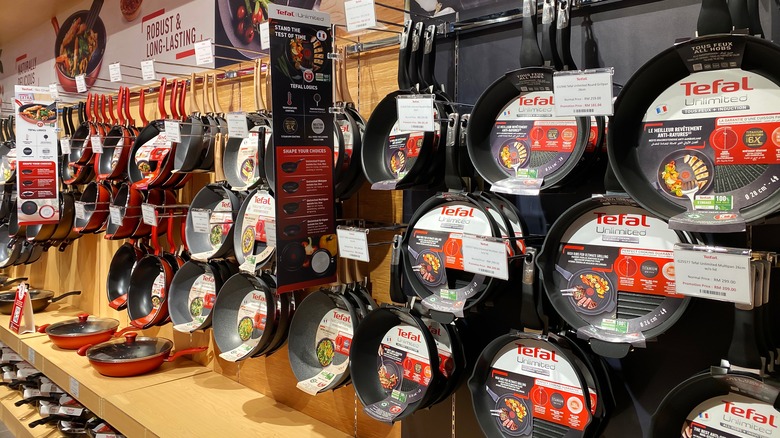The Story Behind The Accidental Invention Of Teflon
When it comes to Teflon (or polytetrafluoroethylene (PTFE), as it's more uncommonly known), the synthetic "unsticky" polymer (via Kitchn) has managed to sneak its way into just about all facets of our lives. While it's commonly known to be the non-stick coating covering cookware, Teflon's uses go way beyond keeping eggs from stubbornly sticking to the sides of pans. According to Northern Engineering (Sheffield) Ltd. (NES), Teflon is used in everything from nail polish — keeping those expensive nail polish jobs looking smooth and free from cracks — to waterproof jackets like Gore-Tex. Teflon's applications are immense.
And while Teflon today is so common that most of us don't even think about the synthetic polymer anymore, there was a time not very long ago, in fact, that the world didn't realize the immense possibilities lying within the miracle compound. Circa 1938, DuPont chemist Roy Plunkett, along with his assistant, Jack Rebok, were working on a project to develop a refrigerant that could be used as an alternative to Freon (via Darment). A chlorofluorocarbon discovered in the early 1930s, Freon's use exploded throughout the decade as refrigerators became more and more affordable to the general population. Being extremely toxic to humans, however, especially with any kind of lengthy exposure (via Healthline), DuPont began exploring alternatives to the inert, but deadly, gas.
Stick no more vile eggs
While working in DuPont's labs, located in Edison, New Jersey, Plunkett and Rebok stumbled upon polytetrafluoroethylene (via ThoughtCo.). Described as a "white, waxy solid" (via Teflon), it had a high melting point, while still remaining chemically stable. Plunkett began experimenting with the new material to determine if it had any viable applications. Catching wind of Plunkett's discovery, DuPont quickly swooped in to see what the hullabaloo was all about. By February 1941, Plunkett was awarded the patent for "Tetrafluoroethylene Polymers" (via Suiter Swantz), aka Teflon. In 1945, DuPont created a partnership with General Motors, forming Kinetic Chemicals (via American Physical Society). The new company trademarked the word "Teflon," with products being sold using the new polymer the following year (via NTE). According to Science History Institute, one of the first uses for Teflon, in fact, was for parts that needed to withstand high levels of corrosion. Once coated with Teflon, those parts made their way over to the Manhattan Project, for use on the world's first atomic bombs.
It wasn't until 1954, however, that the idea for using the polymer as a "non-stick" coating for pots and pans was finally realized. According to London's Science Museum, Colette Grégoire was inspired by watching her husband, engineer Marc Grégoire, use Teflon on his fishing gear. Thinking back to how stubborn eggs loved to stick to her pans, Colette suggested to him that they use Teflon to coat their cookware.
A health hazard
Gregoire accepted the challenge, discovering a way for Teflon to adhere to aluminum (via How Stuff Works). The couple began selling their coated cookware almost immediately, founding and trademarking "Tefal" in 1956 (via Tefal). Deriving its name from the words "Teflon" and "Aluminum," Tefal's cookware would soon become world recognized.
In more recent years, Teflon's reputation has been facing backlash due to ongoing health concerns. According to Eco Parent, up until 2015, Teflon was made using a chemical known as perfluorooctonoic acid (PFOA). While the effects of PFOA are debatable, the chemical is believed to be not only carcinogenic, but a hormone disruptor, as well. Since then, however, DuPont agreed to change how the polymer was made, dropping PFOA out of the process (via Phys.org). And while WebMD states that "Teflon on its own is safe and can't harm you when you ingest it," exposure to Teflon at high temperatures can cause fumes that can lead to a whole host of problems, including changes to liver enzymes, decreased birth weights and a whole host of increased cancer risks (via WebMD).


